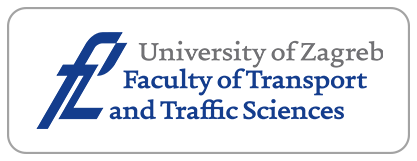A Study on Traffic Flow Distribution in Road Networks Considering the Impact of Construction Zones

Downloads
The construction of urban expressways will significantly impact the travel of surrounding residents. Traffic flow assignment is a key method to address this issue. This study, therefore, addresses the impact of urban expressway construction on nearby residents’ travel by proposing an optimised traffic flow assignment method. Traditional methods rely on labour-intensive OD (origin-destination) matrix acquisition, but this research introduces an OD reverse derivation model that eliminates the need for a prior matrix. Key road sections are identified using the stepwise point placement method, with peak-hour traffic volumes surveyed. An incremental assignment method generates a distribution matrix, and the original OD matrix is derived using a maximum entropy-based model. A stochastic user equilibrium assignment model incorporating a path length-corrected logit is constructed, and a genetic algorithm solves the objective function. Using evening peak traffic data from Huai’an’s road network, including an expressway construction zone, the results show that total travel time decreased by 14.11% after applying the method, from 4,050,327.517 seconds to 3,478,967.635 seconds. This demonstrates the proposed method’s effectiveness in reducing congestion and improving travel efficiency for surrounding residents.
Downloads
Brusselaers N, Huang H, Macharis C, Mommens K. A GPS-based approach to measure the environmental impact of construction-related HGV traffic on city level. Environmental Impact Assessment Review. 2023;98:106955. DOI: 10.1016/j.eiar.2022.106955.
Bidkar O, Arkatkar S, Joshi G, Easa SM. Effect of construction work zone on rear-end conflicts by vehicle type under heterogeneous traffic conditions. Journal of transportation engineering, Part A: Systems. 2023;149(4):05023001. DOI: 10.1061/JTEPBS.TEENG-7275.
Ma R, Liu N. Simulation study on the influence of metro occupation construction on road capacity of mixed traffic intersection. In Second International Conference on Applied Statistics, Computational Mathematics, and Software Engineering (ASCMSE 2023) 2023; 12784: 450-459. DOI: 10.1117/12.2692077.
Yu C. Study on traffic organization strategy for occupying-road construction of Qingkou interchange on Shenhai expressway. In IOP Conference Series: Earth and Environmental Science. 2021;820(1):012017. DOI: 10.1088/1755-1315/820/1/012017.
Yan Z, Li L, Chen F, Xu Z. Study of expressways with heavy traffic flow during occupying-road construction. SPIE, In International Conference on Smart Transportation and City Engineering. 2021;12050:353-358. DOI: 10.1117/12.2614115.
Morandi V. Bridging the user equilibrium and the system optimum in static traffic assignment: A review. 4OR. 2024;22(1):89-119.
Xu X, et al. A unified dataset for the city-scale traffic assignment model in 20 US cities. Scientific data. 2024;11(1):325.
Hazelton ML, Najim L. Using traffic assignment models to assist Bayesian inference for origin–destination matrices. Transportation Research Part B: Methodological. 2024;186:103019. DOI: 10.1016/j.trb.2024.103019.
Rong C, Ding J, Li Y. An interdisciplinary survey on origin-destination flows modeling: Theory and techniques. ACM Computing Surveys. 2023. DOI: 10.1145/3682058.
Pamuła T, Żochowska R. Estimation and prediction of the OD matrix in uncongested urban road network based on traffic flows using deep learning. Engineering Applications of Artificial Intelligence. 2023;117:105550. DOI: 10.1016/j.engappai.2022.105550.
Owais M. Deep learning for integrated origin–destination estimation and traffic sensor location problems. IEEE Transactions on Intelligent Transportation Systems. 2024;25(7): 6501-6513. DOI: 10.1109/TITS.2023.3344533.
Cantarella GE, Fiori C. Multi-vehicle assignment with elastic vehicle choice behaviour: Fixed-point, deterministic process and stochastic process models. Transportation Research Part C: Emerging Technologies. 2022;134:103429. DOI: 10.1016/j.trc.2021.103429.
Verstraete J, Tampère C. Recursive logit route choice modelling for traffic assignment. In Proceedings of 9th Symposium of the European Association for Research in Transportation. European Association for Research in Transportation. 2021.
Kumar S, Gupta A, Bindal RK. Load-frequency and voltage control for power quality enhancement in a SPV/Wind utility-tied system using GA & PSO optimization. Results in Control and Optimization. 2024.100442. DOI: 10.1016/j.rico.2024.100442.
Huang W, et al. Railway dangerous goods transportation system risk identification: Comparisons among SVM, PSO-SVM, GA-SVM and GS-SVM. Applied Soft Computing. 2021;109:107541. DOI: 10.1016/j.asoc.2021.107541.
Bemani A, et al. Modeling of cetane number of biodiesel from fatty acid methyl ester (FAME) information using GA-, PSO-, and HGAPSO-LSSVM models. Renewable Energy. 2020;150:924-34. DOI: 10.1016/j.renene.2019.12.086.
Nguyen S. Modele de distribution spatiale tenant compte des itineraries. INFOR. 1983;21(4):270-292.
Willumsen LG. Estimating time-dependent trip matrices from traffic counts. In Papers presented during the Ninth International Symposium on Transportation and Traffic Theory held in Delft the Netherlands. 1984;11-13.
Cascetta E. Estimation of trip matrices from traffic counts and survey data: a generalized least squares estimator. Transportation Research Part B: Methodological. 1984;18(4-5):289-99. DOI: 10.1016/0191-2615(84)90012-2.
Doblas J, Benitez FG. An approach to estimating and updating origin–destination matrices based upon traffic counts preserving the prior structure of a survey matrix. Transportation Research Part B: Methodological. 2005;39(7):565-91. DOI: 10.1016/j.trb.2004.06.006.
Spiess H. A maximum likelihood model for estimating origin-destination matrices. Transportation Research Part B: Methodological. 1987;21(5):395-412. DOI: 10.1016/0191-2615(87)90037-3.
Behara KN, Bhaskar A, Chung E. A novel methodology to assimilate sub-path flows in bi-level OD matrix estimation process. IEEE Transactions on Intelligent Transportation Systems. 2020;22(11):6931-41. DOI: 10.1109/TITS.2020.2998475.
Li C, Zheng L, Jia N. Network-wide ride-sourcing passenger demand origin-destination matrix prediction with a generative adversarial network. Transportmetrica A: Transport Science. 2024;20(1):2109774. DOI: 10.1080/23249935.2022.2109774.
Zhang R, et al. Cognition-driven structural prior for instance-dependent label transition matrix estimation. IEEE Transactions on Neural Networks and Learning Systems. 2024;1-14. DOI: 10.1109/TNNLS.2023.3347633.
Hussain E, Bhaskar A, Chung E. Transit OD matrix estimation using smartcard data: Recent developments and future research challenges. Transportation Research Part C: Emerging Technologies. 2021;125:103044. DOI: 10.1016/j.trc.2021.103044.
Krishnakumari P, Van Lint H, Djukic T, Cats O. A data driven method for OD matrix estimation. Transportation Research Part C: Emerging Technologies. 2020;113:38-56. DOI: 10.1016/j.trc.2019.05.014.
Wardrop, JG. Road paper: Some theoretical aspects of road traffic research. Proceedings of the institution of civil engineers. 1952;1(3):325-362. DOI: 10.1680/ipeds.1952.11259.
Fisk CS, Boyce DE. Alternative variational inequality formulations of the network equilibrium-travel choice problem. Transportation Science.1983;17(4):454-463. DOI: 10.1287/trsc.17.4.454.
Daganzo CF, Sheffi Y. On stochastic models of traffic assignment. Transportation Science. 1977;11(3):253-274. DOI: 10.1287/trsc.11.3.253.
Fisk C. Some developments in equilibrium traffic assignment. Transportation Research Part B: Methodological. 1980;14(3):243-255. DOI: 10.1016/0191-2615(80)90004-1.
Wang W, Sun HJ. Cumulative prospect theory-based user equilibrium model with stochastic perception errors. Journal of Central South University. 2016;23(9):2465-2474.
Yan DM, GuoJ H. A stochastic user equilibrium model solving overlapping path and perfectly rational issues. Journal of Central South University. 2021;28(5):1584-1600.
Krishnakumari P, Van Lint H, Djukic T, Cats O. A data driven method for OD matrix estimation. Transportation Research Part C: Emerging Technologies. 2020;113: 38-56. DOI: 10.1016/j.trc.2019.05.014.
Phillips SJ, Anderson RP, Schapire RE. Maximum entropy modeling of species geographic distributions. Ecological modelling. 2006;190(3-4):231-259. DOI: 10.1016/j.ecolmodel.2005.03.026.
Traub JF, Woźniakowski H. Convergence and complexity of Newton iteration for operator equations. Journal of the ACM (JACM). 1979;26(2):250-258.
Wang J, et al. Combined multinomial logit modal split and paired combinatorial logit traffic assignment model. Transportmetrica A: Transport Science. 2018;14(9):737-760. DOI: 10.1080/23249935.2018.1431701.
Zhang S, An HK. A novel road traffic flow prediction model using hybrid Particle Swarm Optimization (PSO) and Radial Basis Function Neural Network (RBFNN). Journal of Autonomous Intelligence. 2023;6(2):883. DOI: 10.32629/jai.v6i2.883.
Fellendorf M, Vortisch P. Validation of the microscopic traffic flow model VISSIM in different real-world situations. In transportation research board 80th annual meeting 2001 Jan (Vol. 11).
Copyright (c) 2025 Shanhua ZHANG, Hong Ki AN, Choon Wah YUEN

This work is licensed under a Creative Commons Attribution-NonCommercial 4.0 International License.




















